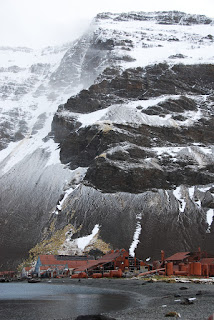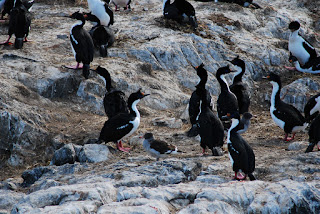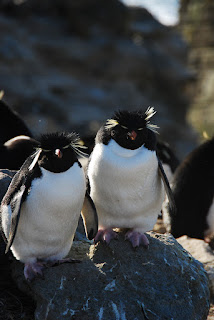After sailing away from our
unforgettable four days on South Georgia, life on the MV Ushuaia reverted to
its usual routine during a crossing:
three big meals a day, a lecture or briefing every morning and
afternoon, lots of reading and watching seabirds and a feeling of suspended
animation. When the sea was calm, I was
fairly functional, but if the swell kicked up a bit, I took to my bunk to sleep
and read. In retrospect, I should have
made use of the scopalomine patches that I had bought on the recommendation of
my sister, but I preferred to try to sleep off the low-level seasickness.
 |
| Iceberg floating past South Georgia |
Our trip down from South Georgia
to the Antarctic Peninsula was long, the longest crossing of the trip. We left on the late afternoon of the 5th,
after our sail up Drygalski Fjord, and didn’t come into sight of land until
nearly sunset on the 8th, when we passed Clarence Island and, in the
distance, Elephant Island, another key site in the Shackleton saga in
1917. We did have things to look at,
luckily: lots of icebergs are swept up
along this route by the prevailing currents and waves, and some of the bergs
were a perch for penguins, particularly Adelie penguins. We spotted fur seals swimming in the open
ocean, and two of the keen birdwatchers, Stefan and Andrew, thought they had
seen macaroni penguins swimming by as well.
Of course we had our usual accompaniment of albatrosses (royal,
black-browed and wandering), petrels (Southern giant and Cape), storm petrels,
prions and terns. However the sightings
that got us most excited were whales.
The afternoon that we were sailing towards Drygalski Fjord, Ricky
spotted a spout right beside the boat, and as we gathered to look, we realized
that we were surrounded by between 15 and 20 humpback whales, feeding and
displaying. One of them turned on her
side to give huge flipper slaps to the water surface, presumably to disorient
or stun prey. For at least ten minutes,
there were spouts all around us. At
other times a single spout would appear and then there would be no further sight
of the whale; the biologists said these were probably beaked whales of some
sort. Another day we had a good 8 or so
whales running parallel to the boat, but not close enough to get a real look at
them. It was good to see that with
whaling banned in the Southern Ocean, the number of whales is at least stable
and may be slightly increasing after being pushed to the brink of extinction (for
the right and humpback whales, anyway).
We ran into more headwinds and
contrary currents than anticipated, which meant that we had to jettison plans
to visit Elephant Island as it was too late in the day to go visit in daylight
hours. This was a big disappointment to
Oz, who wanted to see where Shackleton and his men survived for months under an
overturned lifeboat. In the event, we
got a dramatic view of neighbouring Clarence Island as we sailed past; the icy
slopes and big glaciers reminded me a bit of Muztagh Ata.
 |
| First view of the Antarctic Peninsula |
We woke up early on Monday,
November 9th to find ourselves in another world. Overnight we had steamed to the northern tip
of the Antarctic Peninsula at Esperanza Station, and most of us scrambled
outside before breakfast to take pictures of the dramatic scenery. On our right the Antarctic mainland extended
in a series of ice cliffs and tumbling glaciers. On our left a series of islands, ringed by
pack ice, enclosed us in a long, narrow strait of ice-free water.
 |
| Huge tabular iceberg near Esperanza |
We spent the early morning on deck, taking
photos by the dozens of the landscape, of the huge passing tabular icebergs, of
the smaller bergs and their animal denizens (particularly Adelie penguins and
Weddell seals). The colours and shapes
looked unreal, too straight-edged and uniformly white to exist in nature. We used up a lot of camera memory as we
continued steaming towards the Argentinian scientific station at Esperanza, one
of the locations associated with Nordenskjold’s ill-fated expedition in 1901-04.
 |
| Adelie penguins hitching a lift on a berg |
The plan was to land at Esperanza
or at nearby Brown Bluff, one of the largest colonies of nesting Adelie
penguins on the planet. We put on our
landing gear (insulated waterproof trousers and jackets, rubber boots, life
jackets) and lined up for a Zodiac ride to shore. As always, Monika, Agustin, Mariela, Ale and
Kata went first to assess landing conditions.
I thought things looked too windy and rough to even contemplate a
landing, as gale-force katabatic winds howled down off the ice cap to drive big
white=capped waves across the water. I
thought that if it weren’t our first chance to land on the mainland of
Antarctica, there was no way that we would even be thinking about landing. Sure enough, in a few minutes the guides were
back shaking their heads: landing was
out of the question given the conditions.
We were all pretty disappointed, given that we were keen to land on the
seventh continent, but it was the right decision.
 |
| The iceberg that it took us an hour to circumnavigate |
Instead, we did a cruise around
the Antarctic Sound in the ship, taking pictures of the truly massive tabular
icebergs, pack ice, Weddell seals and mainland glaciers. One tabular iceberg was well over a kilometre
long on a side and over 20 metres high (and hence about 180 metres
deep!!). The crew and the guides were
impressed by the quantity of ice floating around; some of them hadn’t seen so
much ice in almost 20 years of sailing to Antarctica. They called it a “Shackleton year”, in memory
of the fact that Shackleton’s 1914 expedition was doomed by a year of
extraordinary quantities of ice. There
are suggestions that the Antarctic Peninsula and parts of West Antarctica are
shedding ice into the ocean at an ever-increasing rate because of warming,
because of water getting underneath the glacial tongue, and because of the
collapse of ice shelves such as Larsen B which releases ice to flow into the
sea more rapidly. Whatever the cause, it
was an unforgettable experience to see the huge, simple shapes and colours of
the outsized icebergs, sort of like being part of a Lawren Harris
painting.
 |
| Imposing iceberg barrier at the mouth of Antarctic Sound |
After lunch, since the wind had
not yet dropped, we set sail early for a long haul around the tip of the
Peninsula and down the west coast towards Brown Station, our next target. As Monika said, the problem with visiting
Antarctica is that the number of places where you can actually land on the
shore is very, very limited, and with 2015-16 being a Shackleton year, some of
that very limited supply of landing spots are ruled out by excessive ice. Deception Island, a famous spot where a
volcanic caldera encloses a hot spring bubbling into the Antarctic Ocean, is
completely iced in this year and it seems unlikely that any tourists will swim
within its natural harbour this season.
As we headed north and then west around the very northern tip of
Antarctica, we had to pick a path between dozens of tabular icebergs, most as
big or bigger than the monster we had sailed around earlier. It was incredibly impressive to see this much
ice, and even the crew popped out on deck to snap photos of the maze of
icebergs on all sides.
 |
| Beautiful calm waters near Brown Station |
We slept well that night, and in
the morning we found ourselves steaming up the Gerlache Strait, close to Brown
Station. The weather was perfect, and
the surface of the ocean was glassy calm, between the increasingly frequent
small icebergs and their irregular surfaces.
One of my favourite images was of an irregularly shaped iceberg with a
swirling natural Jacuzzi pool at one end in which a mother Weddell seal and her
juvenile pup were swimming. There was an
almost unnatural calm over the water and the land, and it was clear that we
would finally be able to land on the Antarctic mainland.
 |
| Weddell seal in his ice jacuzzi |
We split the passengers into two
groups, and Terri and I were in the first group to land at the long-dormant
Brown Base, another Argentinian scientific base. We clambered ashore and were surrounded by
hordes of gentoo penguins on shore and fishing offshore. Cormorants flew by with nest-building
materials in their beaks, snowy sheathbills flew silently by, and Weddell seals
lounged on the shore nearby.
 |
| Finally on the mainland of Antarctica, Brown Base |
Dramatic
glaciated peaks towered over the base, and the waters of Gerlache Strait looked
almost black, like an ancient obsidian mirror.
We wandered around, took photos of the comical gentoos and revelled in
the views. When our shore time was up,
we clambered into a Zodiac and cruised around the glassy waters for another
hour, looking for seals and admiring the glaciers with their calving faces
tumbling into the ocean.
 |
| Amazing colours and textures |
Monika told us
that when she first came to Brown 20 years earlier, the 6 separate glaciers now
visible all flowed together into the ocean some 2 km further out to sea. We saw the cliffs where the cormorants were
building their nests, and admired the icy architecture of the mountains. Monika steered our boat between icebergs, and
even through an icy passage where one huge iceberg had an underwater connection
between two above-water sections. When
we returned to the ship for lunch, we were all greatly satisfied with our taste
of Antarctica.
 |
| Gentoos at Brown |
While we ate, the ship moved a
bit up the Peninsula towards our next destination, Orne Island, a huge nesting
site for chinstrap penguins. The weather
was perfect, and the views over the icecap that covers the entire central spine
of the Peninsula were epic, We passed a
distant Quark Expeditions ship anchored near another penguin colony (the same
ship that would hit an iceberg in the night a few nights later and put a big
gash in her hull) and admired from afar another huge colony of Adelie
penguins.
 |
| Chinstraps dancing |
Orne Island was a tiny gem,
full of chinstraps (which we had not yet seen) and a few rogue gentoos.
 |
| Chinstrap penguin |
We spent our shore time photographing the
chinstraps, the gentoos and the offshore icebergs. Just as Terri and I were turning our back on
the iceberg-filled bay, we heard a big crunch and crack, and running back
uphill, we were in time to see a huge iceberg split in two and then turn over
completely, unbalanced by its new shape and mass.
 |
| Watching the iceberg rolling over at Orne Island |
It was one of the things we had most wanted
to see, and so watching an iceberg turn over felt like the icing on the
cake. We had a group photo taken at the
high point of the island, and then headed back to the ship past a sleeping
Weddell seal that had not moved a centimetre since we had passed it on the way
to shore.
 |
| Lazy Weddell seal |
That night we set sail for the
South Shetland Islands, and in the morning we woke up to a driving blizzard,
through which we could see the islands in the distance. An after-breakfast briefing by Monika
delivered the unwelcome news that a massive weather system was passing through
(the tail end of a full hurricane) and that it was out of the question to try
to land in these conditions. In fact, we
would spend the day hiding in the lee of the South Shetlands and then try to
make a run for it across the Drake Passage at night between the receding
hurricane and another approaching gale.
The Drake Passage crossing was going to be a 9 out of 10 for discomfort.
We spent the day in limbo, having
a lecture, watching videos and then having a wonderful Antarctic Quiz, in which
the team I was on led until the very end, when a round about music and film and
TV themes scuppered us and handed victory to the Argentinian photographic
safari crew.
The two full days spent crossing
the Drake Passage were truly miserable.
The ship rocked and heaved more than ever before, and meals were
impossible, as I could not make it through a meal without being overwhelmed by
nausea. One of the expeditioners, Tom,
was thrown clean out of his berth in the middle of the night and managed,
through sheer luck, to land on his feet.
On the afternoon of the 13th of November we finally came into
sight of the islands south of Tierra del Fuego and within a few hours we were
in the protective lee of the archipelago.
It was such a relief to have a stable ship under our feet that we were
quite giddy as we had the traditional ceremony of getting landing certificates,
having a final toast and then having an Olympian feast for our final
supper.
 |
| Orne Island bergs |
The next morning we woke up to
find the familiar confines of Ushuaia Harbour closing in around us. We had a final massive breakfast and then
lined up to collect our 10% rebate in crisp dollar bills (always useful in the
strange currency exchange world of Argentina!) before being released. Most people headed to the airport that day,
but Terri and I headed to our hotel for long nap and then a walk around
Ushuaia. That evening a few of us who
hadn’t yet left town gathered for a beer or two at the Dublin Pub. It was hard to believe that after 20 days,
our once-in-a-lifetime trip was over. It
was time to head off for new adventures in Patagonia.
Practical Tips: I think that if you’re going to spend the big
bucks and go to Antractica, it’s worth paying more to include South Georgia and
the Falklands, both of which are visually impressive and have incredible
concentrations of birds. They also have more guaranteed landing spots than the Peninsula. It’s also worth
checking whether it’s a big ice year (a Shackleton year) and whether this will
make much of the Antarctic Peninsula’s landing spots inaccessible. A good starting point for any Antarctic
expedition is Daniela Gonzalez’ Ushuaia Turismo website, which lists every single
departure out of Ushuaia, its itinerary and its list price. Last-minute specials are available; the best
price we saw was for US$ 3500 for a 10-day Antarctic Peninsula trip. The longer trips (such as ours) are
discounted much less often and by smaller amounts. It’s a lot of money, but I thought it was
worth every last cent. Just do it!





































